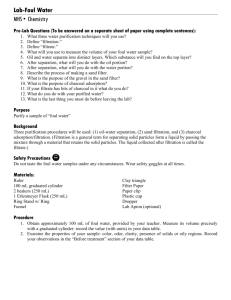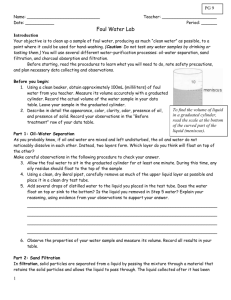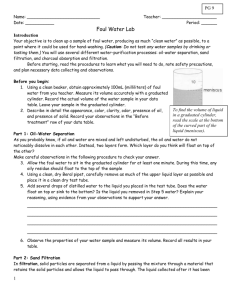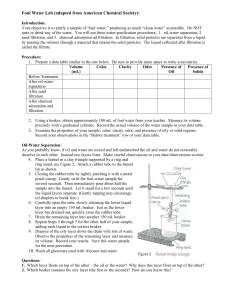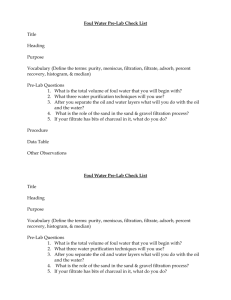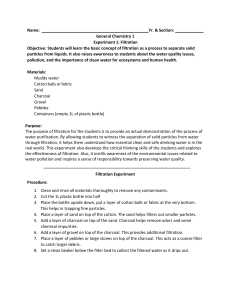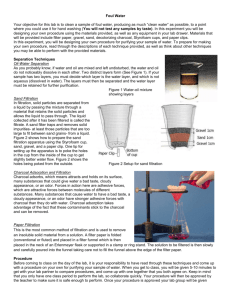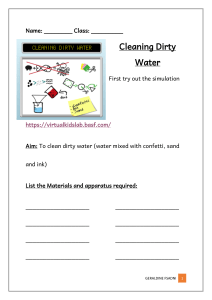1.8 Investigating Matter: Foul Water Introduction
advertisement
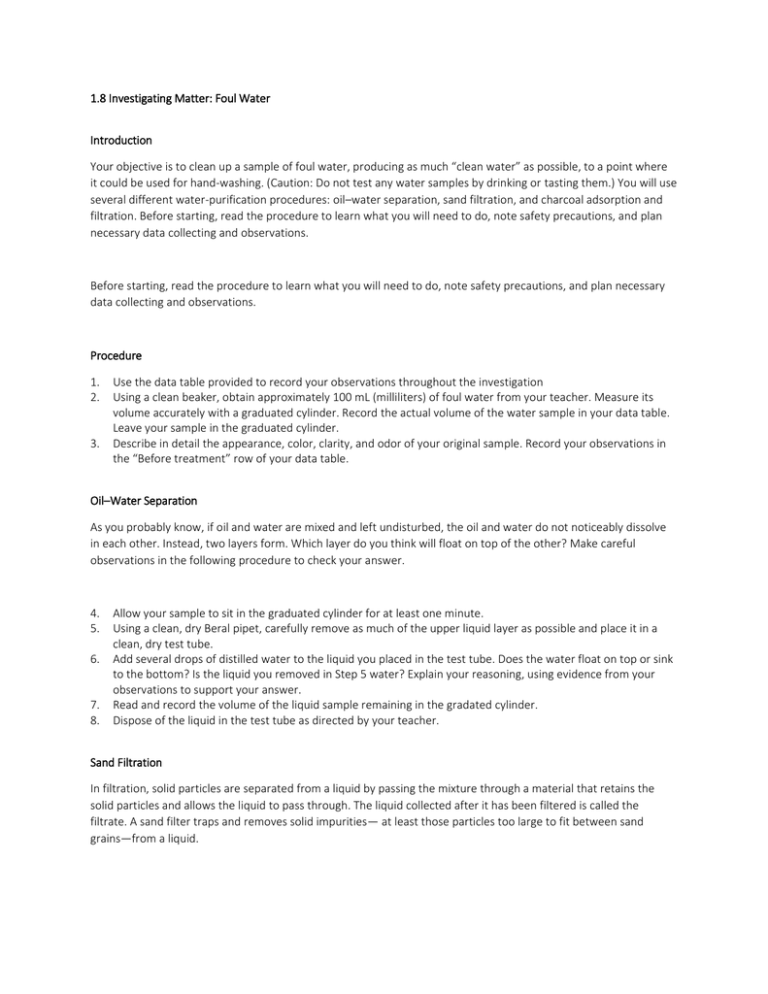
1.8 Investigating Matter: Foul Water Introduction Your objective is to clean up a sample of foul water, producing as much “clean water” as possible, to a point where it could be used for hand-washing. (Caution: Do not test any water samples by drinking or tasting them.) You will use several different water-purification procedures: oil–water separation, sand filtration, and charcoal adsorption and filtration. Before starting, read the procedure to learn what you will need to do, note safety precautions, and plan necessary data collecting and observations. Before starting, read the procedure to learn what you will need to do, note safety precautions, and plan necessary data collecting and observations. Procedure 1. 2. 3. Use the data table provided to record your observations throughout the investigation Using a clean beaker, obtain approximately 100 mL (milliliters) of foul water from your teacher. Measure its volume accurately with a graduated cylinder. Record the actual volume of the water sample in your data table. Leave your sample in the graduated cylinder. Describe in detail the appearance, color, clarity, and odor of your original sample. Record your observations in the “Before treatment” row of your data table. Oil–Water Separation As you probably know, if oil and water are mixed and left undisturbed, the oil and water do not noticeably dissolve in each other. Instead, two layers form. Which layer do you think will float on top of the other? Make careful observations in the following procedure to check your answer. 4. 5. 6. 7. 8. Allow your sample to sit in the graduated cylinder for at least one minute. Using a clean, dry Beral pipet, carefully remove as much of the upper liquid layer as possible and place it in a clean, dry test tube. Add several drops of distilled water to the liquid you placed in the test tube. Does the water float on top or sink to the bottom? Is the liquid you removed in Step 5 water? Explain your reasoning, using evidence from your observations to support your answer. Read and record the volume of the liquid sample remaining in the gradated cylinder. Dispose of the liquid in the test tube as directed by your teacher. Sand Filtration In filtration, solid particles are separated from a liquid by passing the mixture through a material that retains the solid particles and allows the liquid to pass through. The liquid collected after it has been filtered is called the filtrate. A sand filter traps and removes solid impurities— at least those particles too large to fit between sand grains—from a liquid. 9. 10. 11. 12. 13. Using a straightened paper clip, poke small holes in the bottom of a disposable cup. See Figure 1.5 in your textbook. Add pre-moistened gravel and sand layers to the cup (The bottom gravel layer prevents the sand from washing through the holes. The top layer of gravel keeps the sand from churning up when the water sample is poured into the cup.) Gently pour the sample to be filtered into the cup. Catch the filtrate in a beaker as it drains through. Dispose of the used sand and gravel according to your teacher’s instructions. (Caution: Do not pour any sand or gravel into the sink!) Observe the properties of the filtered water sample and measure its volume. Record your results. Save the filtered water sample for the next procedure. Charcoal Adsorption and Filtration Charcoal adsorbs, which means attracts and holds on its surface, many substances that could give water a bad taste, a cloudy appearance, or an odor. 14. Fold a piece of filter paper, as shown in Figure 1.7 in your textbook. 15. Place the folded filter paper in a funnel. Hold the filter paper in position and moisten it slightly so that it rests firmly against the base and sides of the funnel cone. 16. Place the funnel in a clay triangle supported by a ring, as shown in Figure 1.8 in your textbook. Lower the ring so that the funnel stem extends 2 to 3 cm (centimeters) inside a 150-mL beaker. 17. Place no more than one level teaspoon of charcoal in a 125-mL or 250-mL Erlenmeyer flask. 18. Pour the water sample into the flask. Swirl the flask vigorously for several seconds. Then gently pour the liquid through the filter paper. Keep the liquid level below the top of the filter paper; liquid should not flow between the filter paper and the funnel because that might permit unwanted charcoal and other solid matter to seep into the filtrate. 19. If the filtrate is darkened by small charcoal particles, once again filter the liquid through a clean piece of moistened filter paper. 20. When you are satisfied with the appearance and odor of your charcoal-filtered water sample, pour the filtered water sample into a graduated cylinder. Record the final volume and properties of your purified sample. 21. Follow your teacher’s suggestions about saving or disposing of your purified sample. Place the used charcoal in the container that is provided for that purpose. 22. Wash your hands thoroughly before leaving the laboratory. Data Analysis Record all calculations and answers in the space provided. 1. What percentage of your original foul water sample did you recover as purified water? This value is called the percent recovery. Percent recovery __________ 2. What volume of liquid (in milliliters) did you lose during the entire purification process? Volume lost __________ 3. What percent of your original foul-water sample was lost during purification? Percent lost __________ To answer the following questions, first collect a list of percent recovery values for water samples from each laboratory group. 3. Construct a histogram showing the percent recovery obtained by all laboratory groups in your class. To do so, organize the data into equal subdivisions, such as 90.0–99.9%, 80.0–89.9%, and so forth. Count the number of data points in each subdivision. Then use this number to represent the height of the appropriate bar on your histogram, as illustrated in Figure 1.9 of your textbook. 4. What was the largest percent recovery obtained by a laboratory group in your class? What was the smallest? The difference between the largest and smallest values in a data set is the range of those data points. What was the range of percent recovery data in your class? Largest percent recovery __________________________ Smallest percent recovery __________________________ Range of percent recovery __________________________ 5. What was the average percent recovery for your class? Compute an average value by adding all values together and dividing the sum by the total number of values. The result is also called the mean value. Average percent recovery __________ 6. The mean is a mathematical expression for the most “typical” or “representative” value for a data set. Another useful expression is the median value, or middle value. To find the median for percent-recovery data, list all values in either ascending or descending order. Then find the value in the middle of the list— the point where there are as many data points above as below. If you have an even number of data points, take the average of the two values nearest the middle. What is the median percent recovery of all of your class laboratory results? Median percent recovery __________ Data Table Data Table Volume (mL) Before Treatment After oil-water separation After sand filtration After charcoal adsorption and filtration Color Clarity Odor Presence Presence of Oil of Solids
